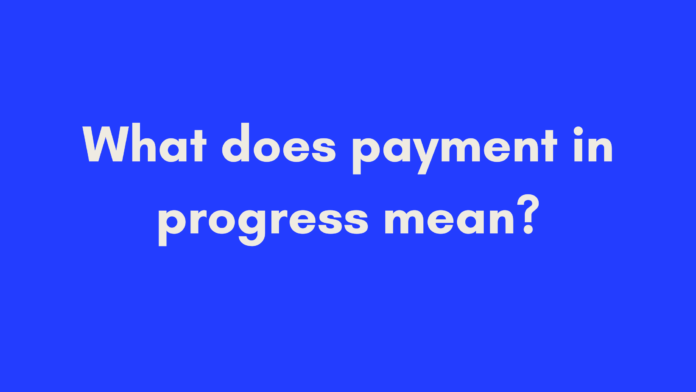Quick Summary
“Payment in progress” indicates that a transaction is underway but hasn’t been finalized yet. This term often appears in various financial contexts, such as unemployment insurance benefits, salary disbursements, and other financial transactions. It signifies that your payment is being processed, which may take hours or even days, depending on the system and institution involved. If you see this status, it’s essential to monitor your payment for updates and be aware that it does not guarantee the immediate availability of funds. Understanding this status can help you manage your expectations and ensure you receive your funds in a timely manner.
Introduction
When you see the phrase “payment in progress,” it often brings a mix of hope and uncertainty. Whether you’re waiting for your unemployment benefits or expecting a refund, this status can affect your financial planning. Understanding what “payment in progress” truly means can help you navigate your finances more effectively and reduce anxiety about your funds.
In this article, we’ll dive deep into the meaning of “payment in progress,” explore its implications in various contexts, and offer valuable insights on how to monitor your payment status. By the end of this post, you’ll have a clearer understanding of what to expect and how to manage your financial transactions confidently.
Understanding Payment Status
Payment status is a crucial aspect of any financial transaction. It serves as an indicator of where your money is in the processing cycle. When you check your payment status and see “payment in progress,” it signifies that the transaction has not yet been completed. But what exactly does this entail?
What Is Payment Processing?
Payment processing is the series of steps that occur from the moment you initiate a transaction until the funds are transferred to the intended recipient. This process generally involves several stages:
- Initiation: You request a payment, whether through an app, bank transfer, or direct deposit.
- Authorization: The payment system verifies that you have sufficient funds or credit.
- Settlement: Once authorized, the payment is processed, and the funds are transferred.
- Completion: The recipient receives the funds, and both parties are notified.
This cycle can take anywhere from a few seconds to several days, depending on various factors like the payment method, the institutions involved, and any potential holds or reviews.
Why Does Payment Status Matter?
Understanding the payment status is essential for several reasons:
- Financial Planning: Knowing when to expect funds helps you budget effectively. For instance, if you’re waiting on a UIF (Unemployment Insurance Fund) payment, it’s crucial to know how long it typically takes so you can plan your expenses accordingly.
- Tracking Claims: If you’ve submitted a claim for benefits, knowing the status can inform you about any necessary follow-ups. For example, if your UIF claim shows “payment in progress,” you can be reassured that your application is being processed.
- Peace of Mind: Monitoring payment status can alleviate anxiety. Seeing “payment in progress” might feel frustrating, but it’s often a good sign that the process is moving forward.
Overall, the payment status serves as a critical tool for managing your finances and expectations effectively. By keeping an eye on it, you can make informed decisions about your money and avoid surprises.
Scenarios of “Payment in Progress”
Understanding the context in which “payment in progress” appears is vital, as it can vary significantly depending on the type of transaction. Here are some common scenarios where you might encounter this status, along with what it generally means in each case.
1. UIF Benefits
When applying for UIF benefits, such as unemployment benefits, seeing “payment in progress” indicates that your claim has been received and is currently being processed. Here’s what this entails:
- Verification Stage: The UIF authorities are verifying your information, which may include checking your employment history and eligibility.
- Preparation of Funds: Once verified, they will prepare your payment for disbursement.
- Estimated Time: Depending on their processing times, it can take anywhere from a few days to a couple of weeks before you see the funds in your account.
2. Bank Transfers
In the context of bank transfers, “payment in progress” often indicates that a transfer request has been initiated. Here are the key points:
- Interbank Transfers: If you’re transferring money between different banks, it may take longer due to the processing times of the respective banks. This is especially true for international transfers, which can take several business days.
- Pending Status: During this period, the amount may be deducted from your account but not yet credited to the recipient’s account, which can cause confusion.
3. E-commerce Transactions
When making purchases online, you might notice “payment in progress” after you hit the checkout button. Here’s what’s happening:
- Order Confirmation: This status indicates that your payment is being processed by the payment gateway.
- Fraud Checks: Payment processors often run fraud checks, which can add time to the process. The retailer will usually notify you once the payment is complete or if there are any issues.
- Inventory Verification: The status may also relate to inventory checks, especially if the item is in high demand.
4. Payroll Processing
For employees, “payment in progress” can appear in the context of payroll. Here’s what it signifies:
- Processing Paychecks: It means that your employer’s payroll system is processing your salary. The funds may not be available in your account until the payroll cycle completes.
- Direct Deposits: If your salary is paid via direct deposit, the bank needs to verify and process the incoming funds before they are available to you.
5. Refunds
If you’re expecting a refund—be it for a product return or a billing error—the status “payment in progress” can indicate that:
- Approval of Refund: The refund request has been approved, and the funds are being prepared for return to your account.
- Variable Timelines: Refunds can take time to process, typically between a few days to a couple of weeks, depending on the merchant and the payment method used.
6. Utility Bills and Subscriptions
When paying utility bills or subscription services, “payment in progress” can signify:
- Billing Cycle Processing: Your payment is being processed during the billing cycle, and it may take time for the company to reflect this in their system.
- Service Continuity: During this time, services should remain uninterrupted, but it’s wise to monitor your account to ensure the payment goes through.
7. Online Payment Platforms
Using platforms like PayPal or Venmo, “payment in progress” usually indicates:
- Payment Verification: The platform is verifying the payment method or checking the sender’s account balance.
- Recipient Notification: The recipient might receive a notification about the incoming payment, but funds won’t be accessible until the processing is complete.
Important Considerations When You See “Payment in Progress”
When you see the status “payment in progress,” it’s essential to keep a few key considerations in mind. Understanding these aspects can help you navigate any uncertainties that may arise during the waiting period for your payment.
1. Processing Time Varies
- Different Time Frames: Processing times can vary significantly based on the type of transaction. For instance, bank transfers may take longer than online purchases due to the verification processes involved.
- Business Days Count: Always consider that weekends and holidays may extend the time it takes for a payment to be completed.
2. Stay Informed
- Check for Updates: Regularly check your payment platform or account for updates. Many systems will provide notifications or status changes that indicate when the payment has moved to the next stage.
- Customer Support: If you’re concerned about delays, don’t hesitate to reach out to customer support for assistance. They can provide you with insights into your specific situation.
3. Documentation
- Keep Records: Maintain documentation of your transaction, such as receipts, confirmation emails, or screenshots. These can be valuable if you need to dispute a transaction or inquire about a delay.
- Tracking Numbers: For shipping-related transactions, having tracking numbers can also help you monitor the payment and delivery status.
4. Beware of Scams
- Phishing Attempts: Be cautious of unsolicited communications claiming your payment is “in progress.” Scammers often use this language to trick individuals into providing personal information or clicking on malicious links.
- Verify Sources: Always verify that you are communicating with legitimate companies or platforms before sharing sensitive information.
5. Be Patient
- Expect Delays: It’s crucial to remain patient during this process. While waiting can be frustrating, understanding that systems may take time to verify and process transactions can help mitigate anxiety.
- Avoid Multiple Attempts: Refrain from initiating multiple payment attempts if you don’t see immediate results. This can complicate the transaction and lead to further delays.
Monitoring Your Payment Status
Keeping an eye on your payment status is essential to ensure everything is progressing smoothly. Here are some practical tips for effective monitoring:
1. Use Notifications
- Enable Alerts: Many payment platforms and banking apps offer notification features. Enable alerts to receive real-time updates about your payment status, so you’re always informed.
2. Online Account Access
- Check Your Account: Log into your account regularly to view the status of your transactions. Most platforms provide a detailed view of recent activity, including pending payments.
3. Track Changes
- Monitor for Changes: Look for any changes in status from “payment in progress” to “completed” or “failed.” Understanding these transitions can help you know when to expect your funds.
4. Communicate with the Recipient
- Stay in Touch: If you’re waiting for a payment from someone, don’t hesitate to check in with them. They might have insights on when they initiated the payment or if they’ve received any notifications from their bank or payment platform.
5. Document Issues
- Record Any Problems: If you notice prolonged delays or discrepancies, document them. This information can be useful if you need to escalate your concern or request a follow-up from customer service.
Conclusion
Seeing the status “payment in progress” can often lead to feelings of uncertainty and anticipation. Understanding what this status means, the scenarios in which it can occur, and how to effectively monitor your payment can make the waiting period less stressful. Always stay informed, be patient, and utilize resources available to you for a smoother experience. By being proactive and vigilant, you can navigate the payment process with confidence.
References
- Unemployment Insurance Fund (UIF) Overview: UIF South Africa
Frequently Asked Questions
When it comes to understanding the “payment in progress” status, many questions often arise. Below are some frequently asked questions that can provide further clarity on this topic.
1. What does “payment in progress” mean?
“Payment in progress” indicates that a payment is currently being processed but has not yet been completed. This status suggests that the transaction is underway, with funds being transferred or verified, but the final confirmation is still pending.
2. How long does a payment stay in progress?
The duration that a payment remains in “progress” can vary depending on several factors, including the payment method, the institutions involved, and whether any additional verification is required. Generally, payments can take anywhere from a few minutes to several business days to process fully.
3. What should I do if my payment is stuck in progress for too long?
If your payment has been in progress for an unusually long time, consider the following steps:
- Check for Notifications: Look for any messages from your payment platform or bank regarding delays.
- Contact Customer Support: Reach out to customer support for assistance. They can provide insights into your specific situation and help resolve any issues.
- Review Your Account: Ensure that there are no pending actions needed on your part to complete the transaction.
4. Can a payment be canceled while it’s in progress?
In many cases, it may be possible to cancel a payment while it is still in progress, but this depends on the payment method and the policies of the financial institution or payment platform. If you wish to cancel a payment, act quickly and check with the respective service provider for their specific procedures.
5. Why do some payments take longer than others?
The processing time for payments can differ based on several factors, including:
- Payment Method: Bank transfers often take longer than credit card transactions due to additional verification.
- Business Days: Payments made on weekends or holidays may experience delays.
- Cross-Border Transactions: International payments typically take longer due to varying banking regulations and processing systems.
6. What are common reasons for a payment to fail?
Payments can fail for various reasons, such as:
- Insufficient Funds: The account linked to the transaction may lack sufficient funds.
- Incorrect Information: Errors in payment details, such as account numbers or recipient names, can lead to failures.
- Technical Issues: Glitches or downtime in payment systems can cause disruptions in processing.
7. Is it safe to wait for a payment in progress?
Generally, yes. If you’re using a reputable payment platform or bank, it’s safe to wait for a payment marked as “in progress.” However, it’s wise to monitor the transaction and stay vigilant against potential scams or phishing attempts.
Author’s Note
As we navigate the complexities of financial transactions, understanding terms like “payment in progress” becomes crucial for managing our expectations and ensuring smooth operations. This article aims to demystify the payment process, offering valuable insights into what “payment in progress” signifies, the various scenarios it may encompass, and the best practices for monitoring your payments effectively.
I’ve drawn on personal experiences and researched extensively to provide you with reliable, in-depth information. My goal is to equip you with the knowledge you need to confidently handle your financial transactions, empowering you to make informed decisions.
While this article serves as a comprehensive guide, I encourage you to consult with financial professionals or customer service representatives from your payment provider if you have specific concerns or unique situations. Remember, understanding your financial processes is key to ensuring your payments are handled securely and efficiently.
Thank you for taking the time to read this article. I hope you find the information helpful and enlightening. Please feel free to share your thoughts, questions, or experiences in the comments section below!

Oliver is a full-time writer with a passion for creating compelling content on diverse topics, including finance, business, product reviews, and more. With a keen eye for detail and a commitment to thorough research, she brings clarity and depth to complex subjects, making them accessible and engaging for readers. Oliver’s dedication to her craft ensures that every article is informative, well-researched, and thought-provoking. Outside of writing, she enjoys exploring new ideas, reading extensively, and continually expanding her knowledge.
Editorial Process
At Trusted Sources, our editorial process is crafted to ensure that every piece of content we produce—whether it’s an informational article or a review—meets the highest standards of accuracy, reliability, and engagement. Our commitment to delivering valuable, research-driven, and reader-centric content is reflected in our systematic and meticulous editorial approach.
Affiliate Disclosure
we are committed to transparency and honesty in all aspects of our operations, including our affiliate partnerships. We participate in various affiliate programs, which means we may earn commissions on qualifying purchases made through links on our Website.


